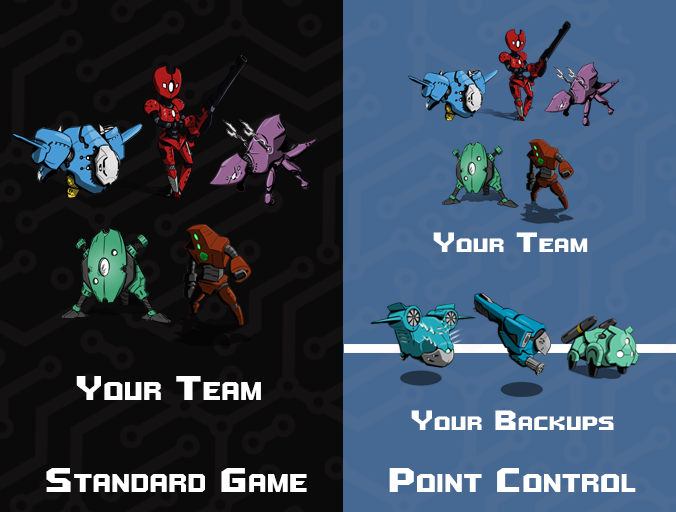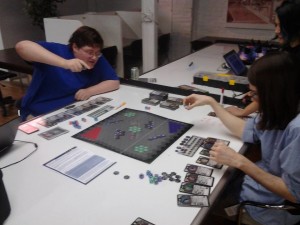A Case in Point Control
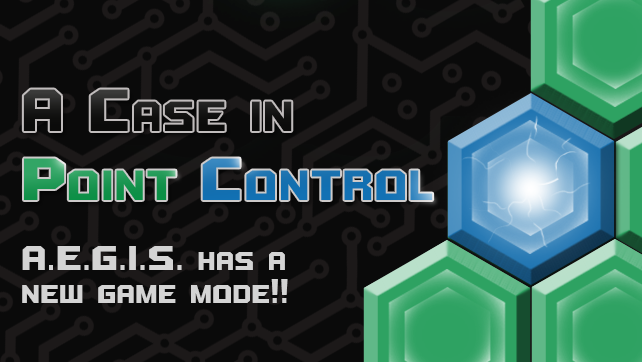
One of the best parts of A.E.G.I.S is that the base system can be used for a wide variety of game modes. We have the two player and four player mode, in both teams combat and free for all, but what about a game mode that changes the core objectives of A.E.G.I.S and encourages a different use of the map? That’s where Point Control comes in.
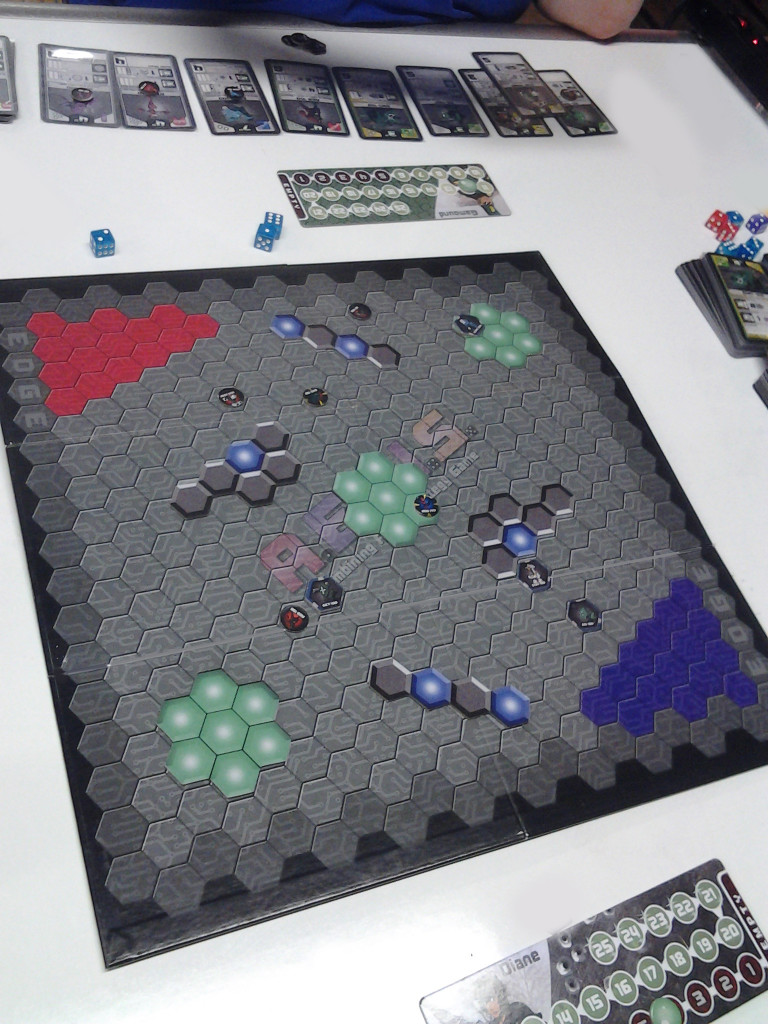
What’s the Point?
Point Control is designed as a longer play format of A.E.G.I.S, with games taking 30-40 minutes instead of the usual 15-20. Players also have access to a larger team of eight robots, although you can still only have five levels worth of robot out at once.
This game mode takes advantage of the game’s forthcoming custom-placement terrain, and introduces Control Points (green hexes) and Entry Points (blue hexes.) When a game begins, the Control Points are placed in the center of the map and the two corners not occupied by player start zones. 6-8 Entry Points are placed where Terrain would normally go. Point Control has a default terrain placement currently.
The main goal of Point Control is to reach a certain amount of points before your opponent, this can be done in several different ways:
[list type=”square”]
- Have your robots on a non-contested Control Point at the start of your turn. You gain points equal to the robot’s level.
- Destroying or fully energy draining an opponent’s robot, you then gain points equal to the robot’s level.
- Destroying multiple robots with one attack, nets you an extra two points on top of the points for each robot that was destroyed.
- Combining your own robots, you get one point for levels two and three, two points for levels four and five.
[/list]
You win Point Control if you have at least 14 points and are leading your opponent by at least 3 or more points.
The game ends if any player has no robots left, cannot produce more than five energy, or have reached the point requirements.
The Finer Points of Point Control:
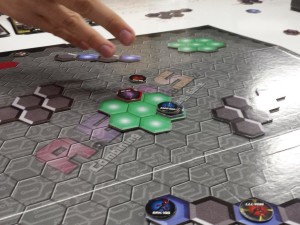
The core mechanics remain the same for Point Control, but the feel of the game is much different. The most important parts of Point Control are the Control Points (Green Hexes) themselves. The Control Points are how you will score a majority of your points. To earn a point, you simply move a robot onto any of the green hexes in that zone. If your opponent does not remove your unit from the zone, you get a point. If an opponent moves one of their units to the same green zone where your unit is located, the point is contested and no player receives points until a robot is removed from the zone. You receive points for the zones you own at the beginning of your turn.
The terrain pieces also change to fit the game type. All terrain pieces in A.E.G.I.S have a reverse side that contain blue hexes. These hexes are the Entry Points for your robots, but they still act as walls. The Entry Points allow you to place new robots on them, if one of your units are destroyed. A new robot is spawned in as long as you have units in reserve, and they replace the level of the unit that was lost. So if you lose a level 2 unit, you may place two level 1 units on Entry Points. Your back up robots must always be level one units and they provide you energy for the turn, and may act normally.
Finally, you must build your team of robots around this game type. Instead of a team of 5 robots you have a team of 8 robots. From these 8 robots you must choose 5 to start on the battlefield with. So you must decide which 5 robots are good for the early game and which robots are better in the late game. The 3 robots not in play sit on a bench until one (or more) of your units in play are destroyed. When a unit of yours is destroyed, you may place a unit from your bench on an entry point.
A Few Pointers on Robots:
Having eight robots opens up many options, but there are a few key things to consider while you’re building your team:
Entry Points: When deciding on your robots, it pays to plan ahead and choose what you want for your starting team and who your back ups will be. You may deploy robots at any Entry Point on the map, so it’s often a good idea to save a high damage unit, such as the AXS-100 or the ENDR-600, toplace on an entry point behind enemy lines and pick off a key target.
Units with Energy Drain are also very effective backups, as units that don’t produce energy aren’t destroyed, and thus can’t be replaced from an EntryPoint. IPPL robots are very useful for this, as they can use Cloaking to approach Entry Points and drain large groups of enemies attempting to hold the point.
Control Points: Keeping control of a point can be a daunting task, but there are a few bots that can help. GET-100 is very powerful at dragging your opponents off points, and units such as the SSM-100 are able to cover entire Control Points in their range from relative safety.
Units with high evasion, such as the ESPR line of bots, are excellent for holding Control Points since they are very tricky to remove.
Getting to the points before your opponents is important, as well as the ability to move between points quickly. Units with Jet are very effective at this task, another option is to use bots with Push attacks, especially the GO-100 with it’s X cost Push, to launch your units towards a point.
Getting to the Point:
A.E.G.I.S is a very versatile game, and we want to show the flexibility in the core mechanics through the different game modes. Point Control is a perfect mode for players who want a longer game with constant skirmishes around the map. We also want to make use of the Terrain Pieces that come with the Core Sets and Point Control allows for that by allowing you to mix up the positions of Entry Points, Control Points, and Terrain.
Point Control is being developed with competitive play in mind, although the official format will continue to be our standard game mode of five robot teams with a two robot sideboard.
Final Points:
We are very excited to introduce this new game mode, as it provides a contrast with A.E.G.I.S.’s standard, quick, best two-out-of-three style of play. We hope this article helps you understand and strategize for this brand new format! If you have any questions or feedback, always feel free to drop us a line on Facebook or Twitter, or email us!

